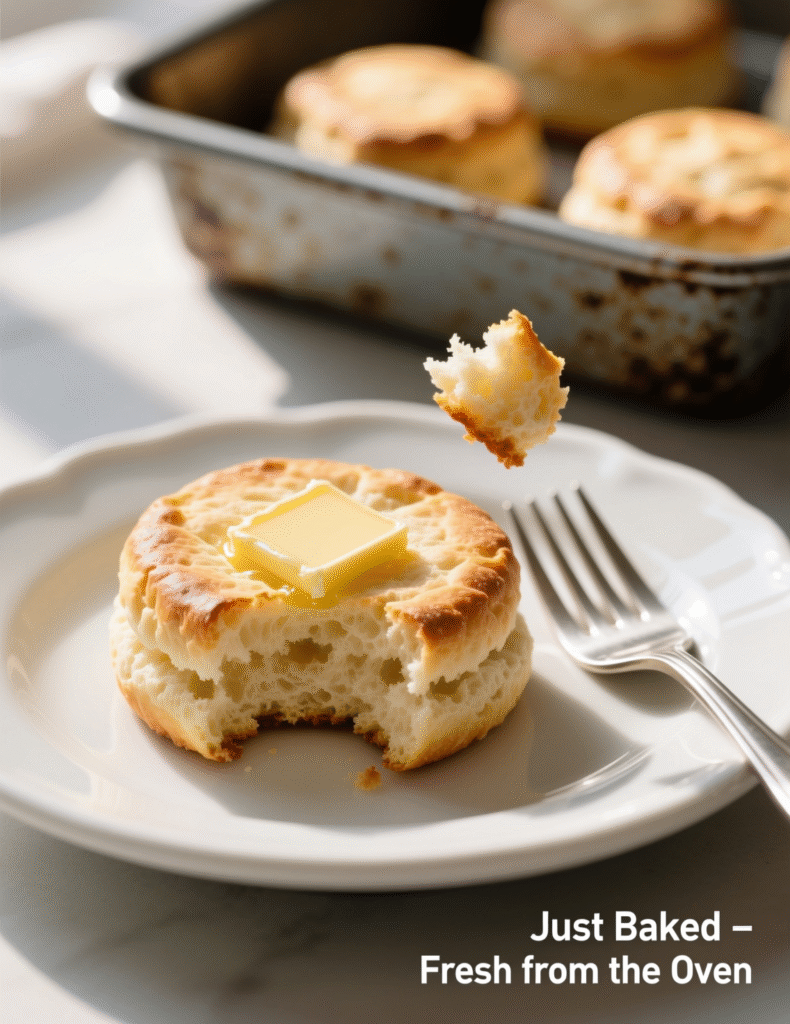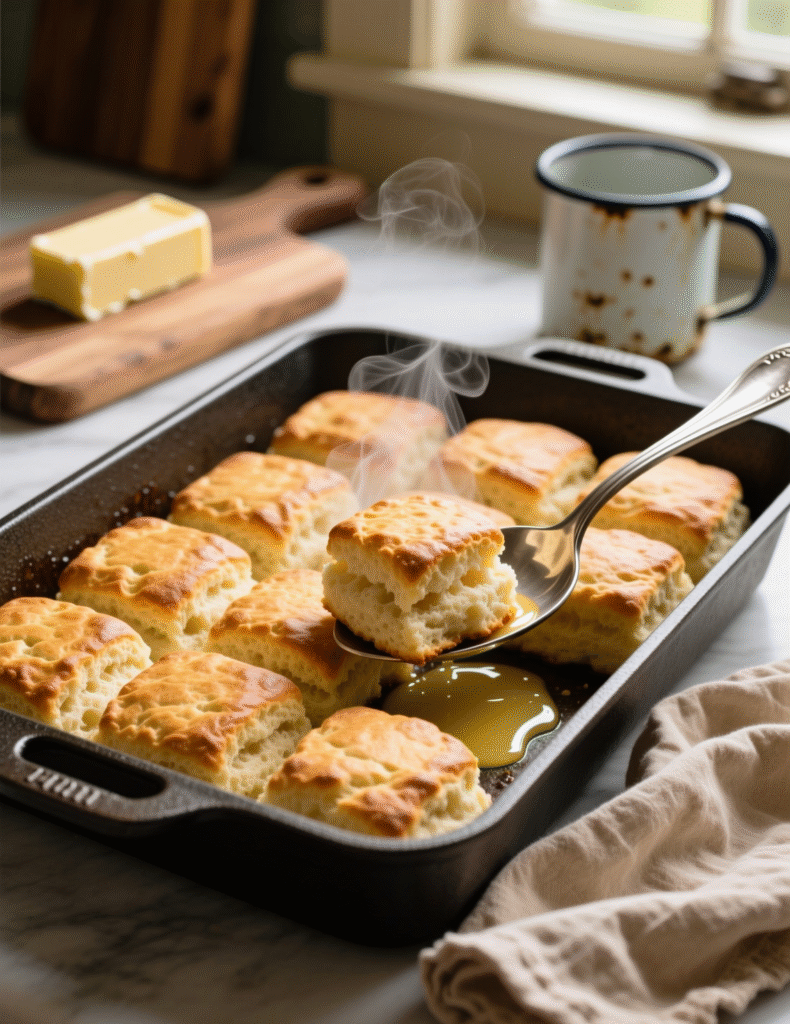Butter swim biscuits are one of those recipes that almost make you laugh when you first see the method. You literally drown the dough in melted butter before baking, and yet, somehow, the result isn’t greasy—it’s golden, tender, and crisp on the edges. For professionals, this recipe isn’t just comfort food; it’s a masterclass in how fat interacts with flour, how hydration drives texture, and how simplicity often outshines complexity in baking. This article dives deep into the technique, the science, and the little secrets that make butter swim biscuits work, with a practical recipe scaled for 12 servings.
Why Butter Swim Biscuits Work So Well
At first glance, the idea looks reckless: dump dough in a pool of butter and bake. But the butter doesn’t just add flavor—it alters the bake environment. It seeps into the bottom crust, crisping it like fried bread. It creates steam pockets that open up the crumb. It prevents sticking while simultaneously carrying flavor into every bite.
The Southern tradition of biscuits leans on high-fat ratios. Most classic recipes use cold butter cut into flour, but this one flips that idea. Melted butter is the medium, not the binder, and that’s why it feels so different. It’s more forgiving for beginners but still rewarding for professionals looking for a foolproof side.
The Recipe in Focus: 12 Servings
When feeding a crowd, consistency matters. Scaling up biscuit recipes often leads to uneven baking, but butter swim biscuits are baked as a single slab, then cut. This eliminates the issue of drying out individual portions. The recipe is straightforward, but every ingredient pulls more weight than you’d expect.
Ingredients for 12 servings
- 4 cups all-purpose flour (480 g)
- 2 tablespoons baking powder (28 g)
- 2 teaspoons granulated sugar (8 g)
- 2 teaspoons kosher salt (10 g)
- 3 cups whole milk (720 ml)
- 1 cup unsalted butter, melted (225 g)
That’s it. Only six items, none exotic, but they balance like a well-rehearsed orchestra. Change one and the whole music shifts.

Step-by-Step Method
- Preheat oven to 450°F (232°C).
- Pour melted butter into a 9×13-inch baking dish. Don’t butter the dish first—the butter is the greasing agent and cooking medium.
- In a bowl, whisk together flour, baking powder, sugar, and salt. No need to sift unless your flour is clumpy.
- Stir in milk until just combined. The dough will look sticky, almost wet. That’s perfect. Don’t overmix.
- Spoon the dough over the butter. Spread gently with a spatula, but don’t force uniformity. Uneven dough makes better texture.
- Using a knife, score the dough into 12 squares before baking. This helps it rise cleanly and makes portioning easier later.
- Bake for 25–30 minutes, until top is golden brown and edges are bubbling.
Once baked, let rest for 5 minutes before cutting fully. Serve warm, preferably with honey, jam, or even a savory gravy.
Texture Analysis
The hallmark of butter swim biscuits is contrast. The top crust bakes golden and flaky, while the bottom develops a nearly fried crunch from direct butter contact. The interior is soft, moist, and airy. Professionals would call this a hybrid crumb—denser than a yeast roll but more open than a traditional biscuit.
The high milk content drives this softness. Milk proteins encourage browning via Maillard reaction, and lactose contributes mild sweetness. The butter forms a shallow confit for the dough, protecting against drying. Compared to classic buttermilk biscuits, these feel richer but less fussy.
The Science of Butter in Biscuit Baking
Butter is more than flavor here. At 80% fat, it delivers richness, while the water content turns into steam. The melted butter in the pan creates a shallow fry environment, caramelizing the starches at the base of each square. That’s why the bottom layer almost shatters when cut.
If you tried this same recipe with oil, you’d lose that sharp flavor and layered structure. Margarine creates waxy notes and won’t crisp as well. Salted butter works but risks throwing off balance if you don’t reduce added salt.
There’s also a thermal factor. Butter has a relatively low smoke point, but at 450°F it performs just at the edge of safety. That’s why the biscuits brown so beautifully without burning in a half hour bake.
Common Mistakes and Fixes
- Dense biscuits – Usually from overmixing. Once liquid hits flour, gluten forms fast. Stir just until there’s no dry flour streaks.
- Greasy bottom – This happens if your oven is cooler than 450°F. The butter won’t emulsify into the dough and will sit heavy. Invest in an oven thermometer.
- Uneven rise – Caused by skipping the pre-score step. Scoring lets steam escape and guides the rise.
- Too salty – Remember, baking powder already has sodium. If using salted butter, drop the added salt by half.
These corrections might sound small, but in professional kitchens, that’s what separates excellence from mediocrity.
Variations for Professionals
Butter swim biscuits are a blank canvas. Here’s where you can flex creativity.
- Cheddar-Jalapeño: Fold 1 cup shredded cheddar and 2 tablespoons minced jalapeño into the dough. The fat in cheese integrates seamlessly.
- Garlic-Herb: Stir 2 teaspoons garlic powder and fresh chopped parsley into the flour. Finish with a brush of melted butter after baking.
- Sweet Cinnamon: Replace sugar with 2 tablespoons brown sugar and add 1 teaspoon cinnamon. These pair well with cream cheese glaze.
- Whole Wheat: Use half whole wheat flour for nuttiness. Increase milk by ¼ cup, since whole wheat absorbs more liquid.
Experimenting shows how flexible the technique is.

Cultural Context and Popularity
Butter swim biscuits gained traction in Southern kitchens but went viral online in recent years, largely due to food bloggers showcasing the simplicity. TikTok and Instagram made them a “weeknight hero” recipe because they skip cold butter cutting. According to Google Trends, searches for “butter swim biscuits” spiked over 600% during the pandemic. Professionals often underestimate viral recipes, but this one has staying power because it respects fundamentals.
Restaurants in Nashville and Charleston now feature skillet butter biscuits on brunch menus, often served with hot honey or pimento cheese. The dish fits the growing demand for rustic, shareable foods that still look indulgent.
Nutrition and Serving Considerations
For 12 servings, each square is hearty. One biscuit contains roughly:
- Calories: 320
- Fat: 17 g
- Carbs: 35 g
- Protein: 6 g
- Sodium: 420 mg
They’re not diet food, but they’re not outrageous compared to croissants or fried bread. In professional service, they can balance a protein-heavy meal or serve as a standalone carb with spreads.
If catering to dietary needs, lactose-free milk or plant-based alternatives like oat milk can substitute, though crumb texture shifts slightly. Vegan butter substitutes often lack enough fat to crisp properly, but high-fat coconut oil blends can work.
Why Professionals Should Care
For chefs, butter swim biscuits are more than just a TikTok darling. They represent a streamlined approach to laminated doughs—showing that flavor and texture can come from technique, not just labor. They offer an easy side that scales for banquets, holds well on buffet service, and adapts to sweet or savory menus.
The recipe also teaches young cooks restraint. Don’t overwork. Don’t overthink. Trust the butter. And sometimes, the simplest approach makes the boldest impact.
Conclusion
Butter swim biscuits are proof that baking doesn’t need to be complicated to be profound. With just six pantry staples and a pan of butter, you get a dish that’s indulgent, reliable, and adaptable. For 12 servings, the method scales beautifully, making it ideal for gatherings, catering, or family meals.
The key takeaways are clear: let butter do the heavy lifting, keep mixing minimal, and bake hot. Professionals who understand why this works can adapt it endlessly, whether for sweet brunch menus or savory dinner service. It’s not just comfort food—it’s a case study in culinary efficiency.
FAQs
What are butter swim biscuits?
They’re biscuits baked in melted butter, creating a crisp bottom, golden top, and soft interior.
How many servings does this recipe make?
This version makes 12 generous servings baked in a 9×13-inch dish.
Can I use salted butter instead of unsalted?
Yes, but reduce the added salt in the recipe by half.
Why is the dough so wet and sticky?
It’s meant to be wet—this ensures a tender, moist crumb after baking.
Can I use buttermilk instead of regular milk?
Yes, buttermilk adds tanginess and slightly denser texture.
Why do I need to pre-score the dough?
Scoring helps guide the rise and makes cutting easier after baking.
Can these biscuits be made ahead?
Yes, bake and store covered at room temperature for a day, then reheat before serving.
Are butter swim biscuits greasy?
Not if baked at the right temperature—450°F ensures crispness, not sogginess.
Can I make them gluten-free?
Yes, use a quality 1:1 gluten-free flour blend, though texture will differ slightly.
What’s the best way to serve butter swim biscuits?
They’re great with honey, jam, gravy, or as a side to hearty dishes.
Can I freeze leftover biscuits?
Yes, wrap tightly and freeze for up to 2 months; reheat in the oven before eating.
Why are they called “swim” biscuits?
Because the dough literally swims in melted butter while baking.

Marie Smith is a passionate recipe blogger, sharing easy, delicious, and creative culinary ideas that inspire home cooks to elevate everyday meals with flavor and simplicity.
